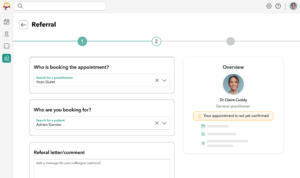
Writing a clear and precise referral letter is an essential skill in the medical field. This document ensures continuity of care and facilitates communication between general practitioners, specialists and other healthcare providers. But how do you structure this type of letter effectively while keeping it concise? Discover our practical 5-step guide along with a sample letter in this article.
What is a referral letter?
A referral letter is a medical document written by a healthcare professional when he or she wishes to direct a patient to another specialist. Its purpose is to share essential medical information to ensure optimal care and continuity of treatment.
In practice, this letter enables your colleague to quickly understand the context, history and expectations related to the referral. When well written, it saves you and your colleagues time and improves the quality of follow-up. Here are the 5 steps to follow:
The 5 steps to write a referral letter
1. Start the letter with patient information
To make sure the colleague receiving your referral letter has the right clinical context, include all essential patient details at the start of the letter, including:
- Name, first name
- Date of birth
- Contact details (phone, email)
- Health insurance number
2. Clearly state the purpose of the referral
Explain in one or two sentences why you are referring the patient. The objective must be explicit to avoid any ambiguity and allow your colleague to quickly understand the issues at stake.
3. Summarise relevant medical history
Do not detail the entire medical history. Focus only on what is useful for the specialist’s management:
- Chronic conditions (e.g. hypertension, diabetes)
- Previous surgeries
- Known allergies
- Current medication (with dosage)
4. Describe recent symptoms and results
Include only clinical findings and tests directly related to the request:
- Symptoms (frequency, intensity, progression)
- Relevant lab or imaging results
- Recent physical findings
5. Clearly define your expectations in the referral letter
Indicate what you expect from the specialist: a diagnosis, an opinion, a treatment plan or specific follow-up. This prevents misunderstandings.
Example: “I request your expertise to rule out coronary artery disease and, if necessary, to propose further tests or a therapeutic adjustment.”
Example of a referral letter
Simplified template for a cardiology referral
Dr. Emily Brown
Cardiology Department, ABC Hospital
Geneva, 6 September 2024
Patient: John Doe, born 01.01.1980, tel. 079 XXX XX XX
Dear Dr. Brown,
I am referring Mr John Doe to you for an evaluation of persistent chest pain. For the past 3 months, these symptoms have occurred with exertion and have not completely subsided at rest. His ECG shows ST-segment abnormalities and his tests reveal hypercholesterolemia.
Medical history: Hypertension treated with Lisinopril 10 mg/day, hypercholesterolemia, family history of cardiovascular disease. No previous surgery. No known allergies.
Expectations: Specialised cardiology evaluation to rule out coronary artery disease and propose a possible treatment plan.
Thank you in advance for your expertise and recommendations.
Sincerely,
Dr. Gregory House
Simplified template for a pulmonology referral
Dr. Laura Schmidt
Pulmonology Department, XYZ Hospital
Lausanne, 15 October 2024
Patient: Mr Jean Martin, born 12.07.1972, tel. 078 XXX XX XX
Dear Dr. Schmidt,
I am referring Mr Martin for a specialist evaluation of suspected sleep apnoea. For several months, his wife has reported loud snoring and night-time breathing pauses. The patient complains of persistent fatigue, daytime sleepiness and difficulty concentrating.
Medical history: Hypertension treated with Amlodipine 5 mg/day, BMI 31. Smoker, no known allergies. No surgical history.
Expectations: Pulmonology evaluation with polysomnography, diagnostic confirmation and a proposal for appropriate management (e.g. CPAP or other treatment).
Thank you for your expertise and recommendations.
Sincerely,
Dr. Claire Bridges
Simplified template for a psychiatry referral
Dr. Marc White
Psychiatry Department, Belle-Rive Clinic
Geneva, 22 October 2024
Patient: Ms Sarah Lopez, born 03.04.1990, tel. 076 XXX XX XX
Dear Dr. White,
I am referring Ms Lopez for a psychiatric evaluation due to persistent anxious and depressive symptoms. For more than six months, she has presented with low mood, marked loss of interest, sleep disturbances and recurrent anxiety attacks, despite weekly psychological follow-up.
Medical history: No major somatic condition known. Family history of generalised anxiety disorder on the maternal side. No current medication, no known allergies.
Expectations: Specialised psychiatric evaluation to confirm the diagnosis, propose pharmacological treatment if indicated and coordinate therapeutic follow-up.
Thank you in advance for your help with this case.
Sincerely,
Dr. Alice Liddel
The referral letter in brief
An effective referral letter does not need to be pages long: a well-structured half page is enough. Include key patient information, adapt the content to the specialty, use paragraphs or lists for clarity and don’t forget to include your contact details. In short, follow five simple steps: patient identification, purpose of the referral, relevant history, description of symptoms and clear expectations.
To simplify this process even further, OneDoc provides tools to refer your patients easily and to receive referral requests from your colleagues. A practical solution to streamline collaboration between healthcare professionals and ensure optimal continuity of care.







